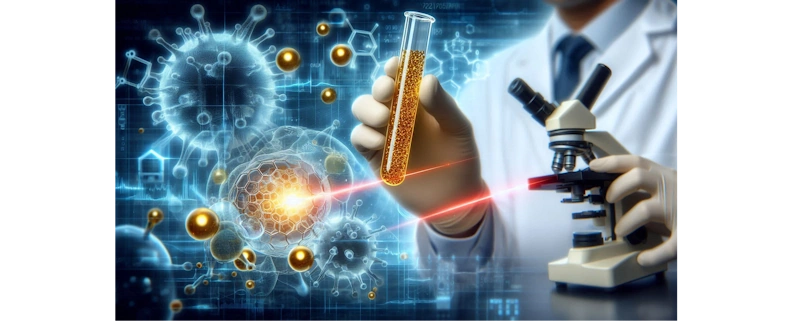
Introduction to Gold Nanoparticles
What are nanoparticles
Nanoparticles are extremely small, reaching a size of one nanometer, or a billionth of a meter. Their tiny size makes them undetectable to the naked eye, requiring a specialized electron microscope to observe. Advances in imaging technologies during the 1990s and 2000s made the field of nanoscience possible.
Nanoparticles are of great interest to scientists due to their unique physical and chemical properties. Their geometric shape and the arrangement of atoms on their surfaces influence these properties. The goal of nanoparticle research is to understand and control their shapes, which could pave the way for new applications in materials chemistry, including the conversion of carbon dioxide into fuel. Nanoparticles are studied using 3D models that represent their geometric shapes. These models can be created with paper or 3D printing equipment.
Gold nanoparticles deciphered
Gold has always been a source of fascination in its macroscopic state due to its incredible golden color, its rarity, its electronic properties, as well as its resistance over time thanks to its stainless nature. It was only from the 1980s that the world of scientific research began to take a close interest in gold in nanometric form, which has physicochemical properties completely different from those in the massive state.
Indeed nanometric-sized gold is no longer golden but can take on different colors in the visible range, from blue to red depending on its size and shape. Furthermore, at the nanoscale, the redox potential of gold becomes much more negative than in the bulk state, which can lead to new applications in catalysis, for example.
The physical properties of the metal also differ: while solid gold melts at 1063°C, a gold nanoparticle measuring 2.5 nm in diameter melts at 300°C! And again: at the nanometric scale, gold becomes biodegradable. All these new properties have allowed gold particles to rise to the highest level in nano-science research.
Although the study and understanding of nanomaterials is relatively recent, artifacts from ancient Roman times have revealed that the Romans were already using gold in the form of nanoparticles in dyes that they incorporated into works of art such as surprising cup of Lycurgus which dates from the 4th century AD. This cup is famous for its incredible optical properties. If the cup is illuminated by light which is reflected, then it appears green. On the other hand, when we observe the cut by a transmitted light, then it appears red.
It was only in the 1990s that researchers showed that these optical phenomena were due to the presence of gold-silver nanoparticles in the form of an alloy with a little copper.
Optical properties of gold nanoparticles: why does gold turn red when it is nanometric in size
Gold nanoparticles are very small solids which can be dispersed in solution (aqueous or organic), it is therefore a suspension which is called inorganic colloidal suspension. Although with the naked eye it is impossible to distinguish an organic dye dissolved in solution and a colloidal suspension of solid nanoparticles, it is nevertheless possible to highlight the presence of nanoparticles with a simple laser pointer.
By illuminating the colloidal suspension with the laser, it will be possible to see the trajectory of the laser inside the solution whereas this will be impossible with the dye. This is due to the scattering of light by the nanoparticles which are much larger than the organic molecules of the dye.
Gold nanoparticles are mainly studied for their catalytic properties, that is to say their ability to accelerate chemical reactions. A particular form of gold nanoparticle, the 12-sided rhombic dodecahedron, has been identified as being more effective at converting carbon dioxide into combustible materials.
Applications in Medicine
Nanotechnologies: a decisive weapon for curing cancer

The question is rather whether we can manufacture gold nanoparticles in such a way that the opportunities outweigh the risks. Francesco Stellacci, of the Institute of materials science and engineering at ETH from Lausanne created a project to copy nature and modify nanoparticles so that they can deliver medications very precisely inside certain cells without damaging the cell membrane.
Viruses proceed exactly like this to introduce genetic material in a target cell and take control of it. The research consisted in surrounding an envelope of organic molecules hydrophobic and hydrophilic with gold nanoparticles. These experiences made it possible to demonstrate that modifying tiny amounts of the organization of the surface molecules was enough to neutralize the toxicity nanoparticles. The study of interactions between nanoparticles and viruses reserved an even more astonishing surprise: the proven effect that certain particles could be used to suppress infections viral.
Although techniques for treating cancer are progressing, the mortality rate linked to this disease remains very high. Nanotechnologies could considerably improve the effectiveness of treatments, by allowing extremely targeted drug delivery. Chemotherapy is currently the most effective and widespread treatment. The problem is that it delivers substances into the body that destroy cancer cells, significantly weakening the body.
This is where research into nanotechnology could change the situation, by making it possible to send drugs directly to infected cells, via a vectorization process. The treatment becomes more effective and, above all, the patient does not suffer from the side effects induced by traditional chemotherapy.
How is this addressing carried out? Largely thanks to the different environmental conditions between a healthy and cancerous cell. Indeed, at the level of a tumor, the environment is more acidic than around healthy cells. Tumor cells are also made up of specific biological markers, which allow targeting. Today, three nanoparticles constitute excellent candidates for the transport of drug molecules: liposomes, nanocapsules and nanospheres.
The promises of gold nanoparticles
Gold nanoparticles can perform several other functions.
The first and most promising application based on gold nanoparticles is photothermal energy. The idea is to inject gold particles into the patient’s bloodstream. These nanoparticles will preferentially attach to cancer cells. Then, laser light at a precise frequency is applied to the nanoparticles, which heats them. This heating creates irreversible damage to tumor cells and therefore their destruction. This type of treatment makes it possible to reach sensitive areas (neck, brain, lungs) with an effectiveness unlike any current chemotherapies.
The second application is the transport of therapeutic molecules. Covered with molecules allowing the most precise addressing possible, gold nanoparticles transport drugs to tumor cells. After laser heating, the nanoparticles release their drug content. This technique has so far only been successfully tested on cultured cells and animals.
Finally, gold nanoparticles are the subject of research to aid radiotherapy. Radiotherapy involves bombarding tumor cells with ionizing rays to destroy their DNA. Gold nanoparticles, by accumulating on target cells, will multiply the effect of ionizing rays, improving the effect of radiotherapy locally, in this case at the level of tumors.
Even if the promises generated by the potential applications around the use of gold nanoparticles are numerous, it is not tomorrow that they will be generalized in hospitals, since the research phases on these techniques have not yet been completed.
